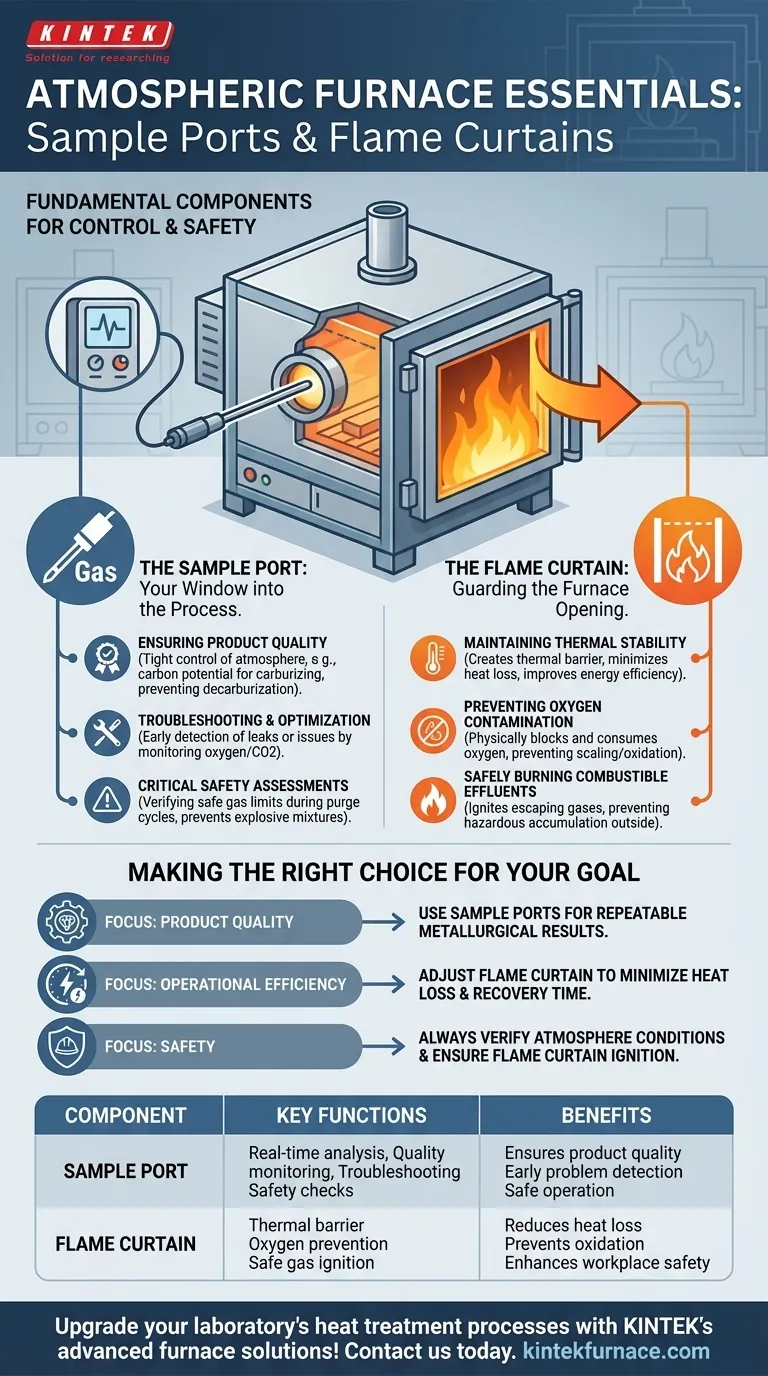In any atmospheric furnace, sample ports and flame curtains are not optional accessories; they are fundamental components for control and safety. Sample ports serve as the primary access point for analyzing the furnace's internal atmosphere, while flame curtains act as a dynamic barrier at door openings to protect the process when loading or unloading.
These two features work in tandem to achieve the core goal of atmospheric heat treatment: maintaining a precisely controlled and isolated chemical environment, free from external contamination, to ensure predictable metallurgical results and safe operation.
The Sample Port: Your Window into the Process
A sample port provides direct, real-time data about the conditions inside the furnace. Without it, operators are effectively running the process blind. Its function is critical for quality, diagnostics, and safety.
Ensuring Product Quality
The chemical composition of the furnace atmosphere directly dictates the outcome of the treatment. For processes like carburizing, the carbon potential of the gas must be tightly controlled to achieve the specified case depth and hardness.
Sample ports allow operators to extract gas for analysis by an oxygen probe or gas analyzer, confirming the atmosphere meets the exact process recipe and preventing costly errors like decarburization or sooting.
Troubleshooting and Process Optimization
An unexpected change in the atmosphere's composition is a clear indicator of a problem. A reading showing high oxygen or carbon dioxide might point to a furnace leak, a failing seal, or a problem with the atmosphere generator.
By regularly monitoring samples, operators can diagnose these issues early, preventing entire batches of parts from being scrapped and minimizing downtime.
Critical Safety Assessments
Many process atmospheres, such as endothermic gas, are combustible and can be explosive if mixed with air in the wrong ratio or below their auto-ignition temperature.
Sample ports are used during purge cycles to verify that the concentration of flammable gas is within safe limits before heating begins or that all oxygen has been removed. This is a non-negotiable safety protocol.
The Flame Curtain: Guarding the Furnace Opening
Every time a furnace door opens, the carefully controlled internal environment is threatened. The flame curtain is the first line of defense against thermal shock and atmospheric contamination.
Maintaining Thermal Stability
Opening a furnace door to ambient air causes immediate and significant heat loss. A flame curtain creates a thermal barrier, reducing the amount of cold air that enters and hot gas that escapes.
This minimizes the temperature drop inside the furnace, which in turn reduces the energy and time required for the furnace to recover to its setpoint, improving overall energy efficiency and cycle time.
Preventing Oxygen Contamination
For most heat treatment processes, oxygen is the enemy. Its ingress can instantly cause scaling (oxidation) on the part surface, ruining the finish and, in many cases, the part itself.
The outward pressure of the flame curtain physically blocks most air from entering. The combustion process itself also consumes any oxygen that does manage to get past the barrier, providing a crucial chemical defense for the parts inside.
Safely Burning Combustible Effluents
When a furnace containing a combustible atmosphere (like endothermic or dissociated ammonia gas) is opened, that gas will rush out. The flame curtain immediately and safely ignites these escaping gases.
This prevents a large, potentially flammable cloud of gas from accumulating in the workspace around the furnace, which could otherwise find an ignition source and cause a dangerous deflagration or flash fire.
Making the Right Choice for Your Goal
Properly utilizing these components is fundamental to consistent and safe furnace operation. Your operational focus will determine where you direct your attention.
- If your primary focus is product quality: Regularly use sample ports to verify your atmosphere's composition, especially carbon potential or dew point, to guarantee repeatable metallurgical results.
- If your primary focus is operational efficiency: Ensure your flame curtain is properly adjusted to minimize heat loss and recovery time each time the door is opened, directly impacting throughput and energy costs.
- If your primary focus is safety: Always use atmosphere analysis from sample ports to confirm conditions are non-explosive during purges, and verify the flame curtain consistently ignites escaping gases.
Mastering the function and maintenance of these components is essential for achieving true control and predictability in your heat treatment operations.
Summary Table:
| Component | Key Functions | Benefits |
|---|---|---|
| Sample Port | Real-time atmosphere analysis, quality monitoring, troubleshooting, safety checks | Ensures product quality, early problem detection, safe operation |
| Flame Curtain | Thermal barrier, oxygen prevention, safe gas ignition | Reduces heat loss, prevents oxidation, enhances workplace safety |
Upgrade your laboratory's heat treatment processes with KINTEK's advanced furnace solutions! Leveraging exceptional R&D and in-house manufacturing, we offer a diverse product line including Muffle, Tube, Rotary, Vacuum & Atmosphere Furnaces, and CVD/PECVD Systems. Our strong deep customization capability ensures we can precisely meet your unique experimental requirements for improved efficiency, safety, and results. Contact us today to discuss how our tailored solutions can benefit your operations!
Visual Guide

Related Products
- Mesh Belt Controlled Atmosphere Furnace Inert Nitrogen Atmosphere Furnace
- 1200℃ Controlled Inert Nitrogen Atmosphere Furnace
- 1700℃ Controlled Inert Nitrogen Atmosphere Furnace
- 1400℃ Controlled Inert Nitrogen Atmosphere Furnace
- Controlled Inert Nitrogen Hydrogen Atmosphere Furnace
People Also Ask
- What industries commonly use inert atmosphere heat treating? Key Applications in Military, Automotive, and More
- How does nitrogen atmosphere heat treatment improve surface strengthening? Enhance Durability and Performance
- How does inert atmosphere heat treating benefit aluminum? Prevent Oxide Buildup for Superior Results
- What is the main purpose of heat treatment? Transform Metal Properties for Superior Performance
- What is the use of nitrogen in furnace? Prevent Oxidation for Superior Heat Treatment



















